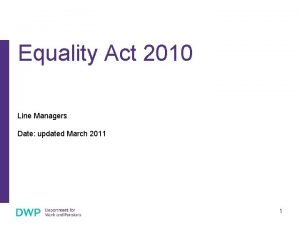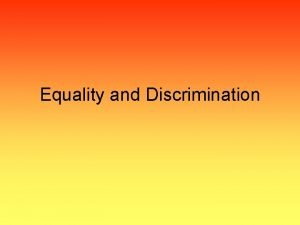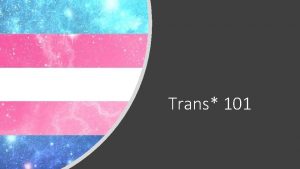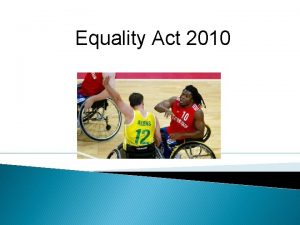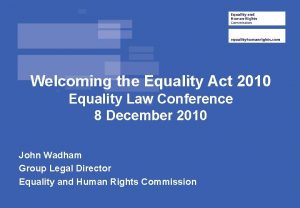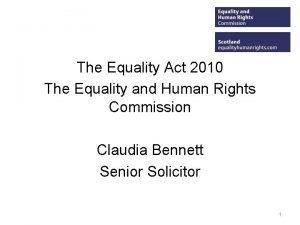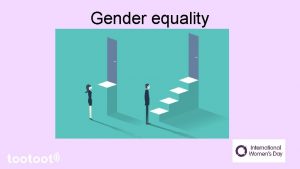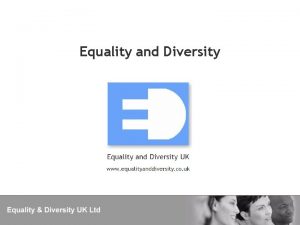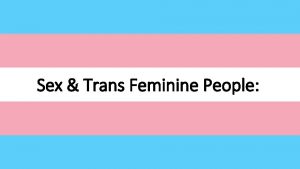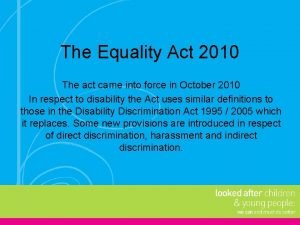Protecting trans people under the Equality Act 2010












- Slides: 12

Protecting trans people under the Equality Act 2010 Charles Bishop

Section 7(1) Equality Act 2010 A person has the protected characteristic of gender reassignment if the person is proposing to undergo, is undergoing or has undergone a process (or part of a Who is protected? process) for the purpose of reassigning the person's sex by changing physiological or other attributes of sex. In simple terms, someone whose gender identity or expression does not correspond to stereotypical expectations of the sex they were assigned at birth.

Key points: Who is protected? Don’t need a gender recognition certificate. Don’t need to be undergoing surgery or having any medical supervision. Might not conform to your views of what a trans person looks like or someone who identifies with that gender. You can be discriminated against because you are perceived to be trans or because of your association with trans people. Good practice to assume it applies to non-binary, agender or very gender non-conforming people: i. e. people who identify outside of the binary options of male/female. Probably wouldn’t extend to a person assigned male at birth who has just said “I’m a woman” without something more indicating a process of reassignment. If you are ensure of a person’s gender identity and it is relevant, it is acceptable to ask them if you do so respectfully (perhaps by asking what pronouns they prefer). Generally, you should treat someone as the gender with which they identify.

When does the Equality Act apply? 1. When you are providing a service to the public 2. When you are exercising public functions 3. Managing premises, including offering them to individuals Best to assume you are always subject to Equality Act provisions.

Discrimination Direct discrimination Key elements: What is unlawful? 1. Treating a trans person less favourably 2. because they are trans E. g. asking a trans woman to prove she has undergone surgery before she can access a service Indirect discrimination Applying a policy to everyone, but it puts trans people at a particular disadvantage, and it cannot be justified by showing the policy is a reasonable means of achieving a legitimate aim. E. g. requiring all service users to provide their birth certificate when other identification would suffice.

What is unlawful? Harassment Victimisation Key elements: 1. Engaging in unwanted conduct 2. that is related to gender reassignment 3. The conduct has the purpose or effect of EITHER: Treating a trans person badly because that person has complained about discrimination. Specifically, they have or it is believed that they may: a) sue under the Equality Act b) give evidence or information in relation to a case under the Equality Act c) do anything in connection with or for the purposes of the Act d) make an allegation about a breach of the Act a) b) Violating the trans person’s dignity Creating an intimidating, hostile, degrading, humiliating or offensive environment for the trans person. E. g. persistently referring to a trans man as “she” and calling him names relating to his gender E. g. refusing access to a trans person who has raised a complaint about transphobia

Don’t forget: Data Protection Act 2018: you cannot reveal personal information to third parties unless one of the specific Data Protection Act exemptions applies. You must observe your data protection obligations when handling a trans person’s personal data. What is unlawful? Note that revealing that someone has a gender recognition certificate can in some instances constitute a criminal offence under section 22 Gender Recognition Act 2004. Public sector equality duty: local authorities must have due regard when making decisions to the need to: Eliminate unlawful discrimination, harassment and victimisation against trans people. Advance equality of opportunity between trans and cisgender people. Foster good relations between trans and cisgender people. This means properly considering the particular vulnerabilities facing trans people and, where necessary, changing policy.

Paragraph 28 of schedule 3 to the Equality Act 2010 While the default position is that excluding trans people from a service is unlawful, in certain circumstances it MAY be lawful if you can demonstrate each of the following: Single-sex services exemption 1. The provision of a single-sex service is itself lawful to begin with: see paras 26 -27 of schedule 3. The thrust of these rules is that you need to show there is a good reason for a single sex-service. 2. There is a legitimate aim (i. e. a good reason) for the exclusion – a potential example is it might lead to the intended users of the service not attending. 3. Exclusion is a proportionate means of achieving that aim, and there was no alternative means of achieving that aim (i. e. not over the top).

Single sexservices exemption “proportionate means of achieving a legitimate aim” Points to consider: Could you achieve the same result by doing something other than excluding them? Have you really thought of everything? Blanket policies unlikely to be proportionate as they would suggest exclusion of all trans people is necessary. You must consider each case separately. Very debatable in law whether or not you could exclude someone who holds a gender recognition certificate, recognising that you should not routinely be asking people for a gender recognition certificate. The limits of this exemption have never been tested in law: but do you want to be the organisation who attracts publicity for being the first to test it? If you believe other service users may object to the trans person being granted access, you wouldn’t be able to act on an assumption alone, but should canvass views (while respecting data protection). Where making a claim as to the particular risk of introducing a trans person to the service, you would need evidence to back that up. If there is a genuine risk presented by an individual, then exclusion is likely to be because of that risk, and not because they are trans.

Paragraph 3 of schedule 23 to the Equality Act 2010 It may be lawful to exclude trans people from communal accommodation with those of the same gender with which they identify, but you must consider: Communal accommodation exemption 1. Whether it is a proportionate means of achieving a legitimate aim 2. Whether and how far it is reasonable to expect that the accommodation should be altered or extended or that further accommodation should be provided – e. g. Single user facilities? Cubicles? Gender neutral provision? 3. The frequency of the demand or need for use of the accommodation by persons of one sex as compared with those of the other

There have not been many cases of discrimination that have reached the courts (but there have been plenty that don’t reach the courts). Two important areas where there has been some litigation: 1. Important cases Retention of historic gender reassignment data: you can retain data on file about gender reassignment, name and title history, but you must be able to show that there is a good reason why certain individuals need to access that information. 2. Application of the public sector equality duty when making housing assessments: if a trans person has a history of hate crime/domestic violence/sexual violence, you must take this into account as a relevant aspect of gender reassignment in the public sector duty.

Questions
 Equality act 2010
Equality act 2010 Substantive equality vs formal equality
Substantive equality vs formal equality Cedaw article
Cedaw article Macbeth act 2 summary
Macbeth act 2 summary Obtaining and protecting your credit vocabulary check
Obtaining and protecting your credit vocabulary check Chapter 9 obtaining and protecting your credit
Chapter 9 obtaining and protecting your credit Chapter 20 civil liberties protecting individual rights
Chapter 20 civil liberties protecting individual rights Reactions of aldehydes and ketones summary
Reactions of aldehydes and ketones summary Ch3li reaction with ketone
Ch3li reaction with ketone Carbamate protecting group
Carbamate protecting group Elizabeth proctor quotes act 1
Elizabeth proctor quotes act 1 Chapter 9 obtaining and protecting your credit
Chapter 9 obtaining and protecting your credit Protecting student data
Protecting student data
